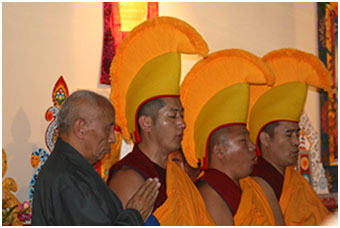Expanding Horizons
For many Americans, every day is a day of prayer. More than half (55%) of Americans said they pray every day, according to a 2013 Pew Research Center survey, while 23% said they pray weekly or monthly and 21% said they seldom or never pray. Even among those who are religiously unaffiliated, 21% said they pray daily. Women (65%) are more likely than men (46%) to pray every day. Older people (60%) are more likely than younger adults (45%) to say they pray daily.
Pew Research Center, 5 facts about prayer, May 7, 2015
When the Pew Research Center revealed these statistics in their excellent online resource, the researcher had in mind the conventional forms of prayer in the U.S. that are largely verbal in nature, at least among Christians, Jews, and Muslims, and typically “set into words” and included in traditional spoken forms such as invocation, praise, thanksgiving, confession, petition, and supplication.
Recently during a visit to the Graduate Theological Union, Tibetan monks opened a public session with chanting in which blessings were offered and sung in deep-toned sounds, calling together mind, body, breathing, and spirit of all sentient beings to focus on the compassionate and peaceful Buddha nature.
 Tibetan Buddhist monks at the GTU library – Photo: GTUFor those who practice a religion other than Buddhism, this was a rare invitation to open oneself to an experience of holiness and reverence that did not rely on the understanding of words or concepts. The activities of the patrons of the library seemed to pause, and people quietly moved to places where they had better access to the tones and cadences of the monks. As the photo indicates, they wore the special ritualistic dress and headgear of their tradition.
Tibetan Buddhist monks at the GTU library – Photo: GTUFor those who practice a religion other than Buddhism, this was a rare invitation to open oneself to an experience of holiness and reverence that did not rely on the understanding of words or concepts. The activities of the patrons of the library seemed to pause, and people quietly moved to places where they had better access to the tones and cadences of the monks. As the photo indicates, they wore the special ritualistic dress and headgear of their tradition.
One of the benefits of living, working, and studying within an interreligious center is that there are many opportunities for personal expansion by exposure to sacred texts, rituals, festivals, worship, and traditions that have been developed, often for thousands of years, but which they have not previously encountered in their particular and limited cultural setting.
I have noticed in my travels among churches and congregations in many states that there is an increasing eclecticism, in the sense that U.S. religious bodies borrow traditions, religious rituals, and practices that previously have not been part of their repertoire. In Protestant mainline settings, these have included the use of cantors, Singing Bowls, pilgrimages, music beyond one’s own heritage, yoga and meditation, drumming, and more. This is part of the religious trend in younger generations who demonstrate the desire to experience global culture widely and to avoid settling too firmly into one fixed tradition.
The Graduate Theological Union is now offering an interreligious concentration in its Master of Arts degree program specifically because students increasingly want to cross boundaries among religious traditions in order to understand difference and critically compare ideas in their deep quest to explore the varying theologies and ethical frameworks of the world’s religions. In the Ph.D. degree program, the faculty has reduced the concentrations to four departments – one of which is Sacred Texts and their Interpretation. Within that department are myriad concentrations that will allow students to study biblical scriptures, classical Islamic texts, Hindu sacred texts, Jewish texts from the Rabbinic and Medieval and Modern period, and more, or to work in more than one tradition. It may be that someday down the line, the Pew Research Center will need to question the U.S. population about an extensive set of prayer practices that include yoga, meditation, sacred service, and others that have not yet reach the mainstream of American life.
